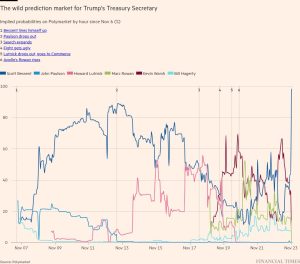How can Rachel Reeves fill the UK’s £40bn Budget gap?
Rachel Reeves has said for months the Budget would be “tough”.
But the scale of the chancellor’s challenges were laid bare by revelations — first reported in the Financial Times — that she is aiming to bridge a larger-than expected shortfall of £40bn.
This lays the ground for massive tax increases, large spending cuts, or more likely both.
What is the gap?
It represents the fiscal repair job Reeves is aiming to undertake, through a combination of tax increases and savings.
The number is an estimate that will probably change — potentially downwards — before Budget day on October 30.
A key component of the hole is the £22bn overspend that Reeves says her officials identified in the 2024-25 fiscal year, but which the chancellor warns will carry on being a problem in future years.
This is partly driven by Reeves’s award of above-inflation public sector pay deals — recommended by independent review bodies — along with spending on areas such as housing and processing asylum seekers and support for Ukraine. Reeves has said help for Ukraine is “absolutely essential and ongoing”.
Assessing how much of the overspend will actually recur in future years is difficult, however, given the Treasury’s refusal to date to break down all the components of that in-year “black hole”. The department turned down an FT freedom of information request on the issue, saying the details were not yet ready.
Is this larger than was expected?
Reeves has referenced a report from the Institute for Fiscal Studies predicting that the Treasury would need to raise £25bn in taxes, telling the New Statesman podcast the figure was too low. This was partly because of ongoing pressures from the overspend, she said.
But she also said one-off costs of compensation for the contaminated blood scandal and compensation over the Horizon IT scandal needed to be added to the tally.
Reeves told the cabinet this week that filling in the £22bn “black hole” this year would only allow public services to “stand still”. She has vowed that there will be no “return to austerity” and wants to avoid real terms cuts to key public services in future — implying further funding needs to be found.
IFS calculations say the Treasury would need to generate £16bn of extra annual funding — on top of existing tax rises laid out in the Labour manifesto — to get departmental budgets growing in line with national income.
What are her priorities?
Reeves told the cabinet this week that her public spending priority is the NHS, an organisation that prodigiously consumes taxpayers’ money. Conservatives say such decisions to raise taxes for more public spending are “a political choice”.
On top of this, Reeves wants to more than meet her new “golden rule” to balance the current budget — excluding investment spending — during the forecast period, which will end in 2029-30.
Building up a buffer makes sense given she is at the beginning of a five-year parliament and will not want to rush through fresh tax rises next year if the public finances take a turn for the worse.
The government has also been signalling that it will boost borrowing for investment, aided by a loosening of its other key fiscal rule, which requires debt to fall in the fifth year of the forecast.
How will they fill the gap?
Mainly through massive tax rises. Reeves’s hands are tied by a Labour manifesto pledge to protect “working people” by ruling out increases in income tax, VAT and national insurance. Allies of Reeves say that she will stick to that pledge, even if reversing Hunt’s £22bn pre-election NI cuts would have solved a lot of her problems at a stroke.
Signals from senior ministers suggest an increase in employers’ national insurance contributions — something Reeves’s allies say does not break the “working people” element of the manifesto promise — will be a key plank of the tax-raising effort. A 2p increase in the levy could, for example, raise £18bn.
But such a large rise would be risky, because economists argue it could disincentivise new hiring by adding costs on employers. Economists say that workers eventually take a hit as the costs are passed on by companies.
An alternative would be to impose NI on employers’ contributions to workers’ pension pots, raising £9bn-£12bn depending on the design, according to the Resolution Foundation. But this could hamper savings, at a time when policy is seeking ways of encouraging working age individuals to build up their retirement plans.
What other taxes are on the menu?
Reeves is planning an increase in capital gains tax, but expectations are relatively low in terms of the likely yield — potentially only single-digit billions a year. Cracking down on loopholes in the inheritance tax regime could add another £1bn-£2bn to the tally.
Tax rises from Labour’s manifesto such as VAT on private school fees will add another £4bn. In addition, the party claimed in the manifesto that it will raise another £5bn by cracking down on tax avoidance.
She would get extra help by going ahead with a further two-year freeze on personal tax thresholds, extending a measure instituted by the last Tory government. This would raise close to £7bn by 2029-30, the final year of the official forecast.
Further fundraising efforts such as an extra levy on banks have also been the topic of discussion.
Will it be enough?
Many economists predict Reeves will probably end up pushing through considerably less than £40bn worth of tax hikes, instead finding savings elsewhere in the budget.
Some help could be found by trimming the welfare budget, but this is unlikely to yield much — not least given how badly stung Labour was by the backlash to its raid on winter fuel payments in July.
Instead, the Treasury may seek savings from other areas of departmental spending, while favouring priority departments such as health, which would compress the overall black hole and ease the scale of the tax hikes.
If the chancellor’s estimate of an ongoing £22bn overspend throughout the parliament proves unduly pessimistic, that would help trim the amount of money that is needed.
Even if the repair job ends up being less than £40bn, it will still represent a massive fiscal fundraising that will reverberate throughout the five-year term of the parliament.
#Rachel #Reeves #fill #UKs #40bn #Budget #gap





